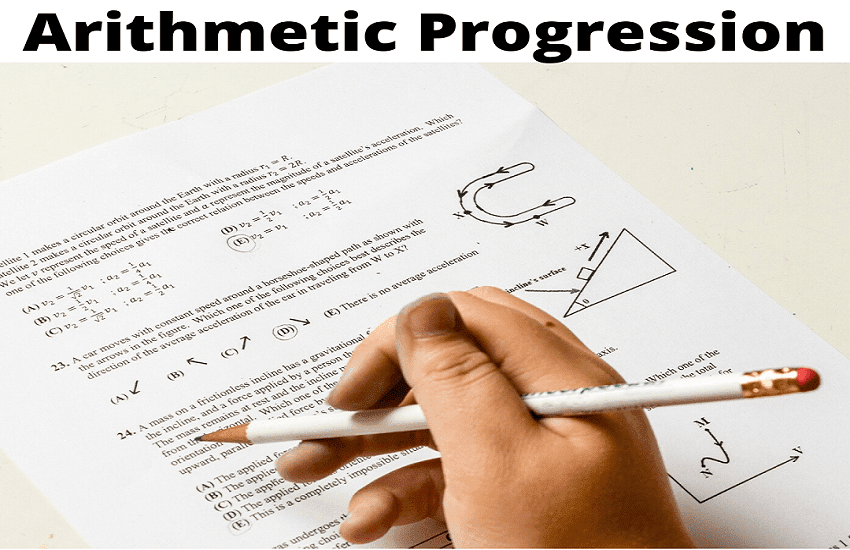
Book Your Free Demo Now!
Arithmetic Progression for class 10th
Progression can be a tough and a big word, especially when one is dealing with mathematics and ‘Arithmetic Progression’ at that! Well, the easiest definition to go by is arithmetic progression is just a sequence of numbers that follow a particular pattern.
What is arithmetic progression?
An arithmetic progression can be understood as a sequence that has a starting number and a series advancing with a definite interval. The simplest and easiest example being the number series 1,2,3,4,5,6,7. Here, the first number is 1 and the definite interval is 1. If we keep on adding 1 to the last number, the sequence will keep on progressing and yes, it becomes an arithmetic progression!
Most used terms in arithmetic progression lesson
Now, let us transform this definition into a mathematical formula to sound more studious. Let us name all the terms first. (Most used terms in arithmetic progression lesson)
When the sign of = comes in picture, an expression becomes an equation. So, the expression 2+4x=6 becomes an algebraic equation.
First term be a1,
Difference be d; and
Last term be an
Now, add ‘d’ to a1. What do you get? (a1+d). It means you got two numbers of the sequence. The two numbers are a1 and (a1+d).
a1 = a1
a2 = (a1+d)
a3 = (a1+d) + d
a3 = a1 + 2d
Similarly a4 can be written as a4 = a1 + 3d;
In the same manner, if you need to find any number of the given arithmetic progression, you can simply apply this trick, and lo, the mathematicians call it a formula. Did you guys realize? You have just made up formula. So, here goes the formula
To find the nth term of any progression?
an = a1 + (n-1)d
Sounds simple right? Well, yes it is. Let’s check it out with the help of one example. My birthdate is 6 so let the first term be 6. And my birth month is 3, so let the difference be 3. We have got a1=6 and d=3. Let us put it into the formula and find out the 11th term of the series.
an = a1 + (n-1)d
a11=6+(10*3)
a11=36
Bingo! As easy as that.
Now that you have learned how to calculate any number in a given arithmetic progression, let’s proceed onto the next formula.
Sometimes, finding the nth term is not enough and you need to find the sum of a definite arithmetic progression. How to go about with that?
Unlock Expert Guidance – Book Help Now!
Avail now by providing the below details

The sum of arithmetic progression
The sum of the nth term of any given arithmetic progression can be calculated by the sum of the first term and the last term divided by half and multiplied by the number of terms in the series. To make it easier, let’s put it into a formula.
Sn=n/2(a1+an)
But this sounds quite simple. When we delve deeper into the subject, you may realize that the nth term is not necessarily given every time. In that case, you need to depend upon another formula, that is:
Sn=n/2{2a1+ (n+1)d}
If you are wondering how we came up with this formula, let me explain to you. We did nothing but substituted the value of an from the previous formula. Let’s check out.
Sn=n/2(a1+an)
But, we know an = a1 + (n-1)d
Let us substitute this value in the Sn formula.
Sn=n/2(a1+an)
Sn=n/2(a1+a1 + (n-1)d)
Sn=n/2{2a1 + (n-1)d}
How cool and easy! Let us take a few examples to understand it better. So, let’s begin with my favorite numbers. Consider the first sequence where a1=6 and d=3, and suppose the last value a be 36. Now, putting these in the first formula of Sn, we will get;
Sn=n/2(a1+an)
Sn=11/2(6+36)
Sn=231
Bravo! Now, let’s proceed with another example where we don’t know what is the last number of the sequence. Suppose the value of a1=3 and d=6, we need to find the sum of the number till the 20th number of the series. Let’s go!
Sn=n/2{2a1 + (n-1)d}
Sn=20/2{2*3 + (20-1)*6}v Sn=10{6+114}
Sn=1200
Did you know? After becoming an expert, you can also calculate the amount collected in your piggy bank (of course, if you add money at proper intervals and don’t cheat). Suppose you initially put 500 in your piggy bank and hereafter keep on adding 100 every month, how much money will you have at the end of the year? Let’s calculate.
a1=500
d=100
n=12
an = a1 + (n-1)d
an = 500 + (12-1)100
an = 1600
So, you will be getting 1600 by the end of the year. Good savings, indeed! In a similar fashion, you can calculate the fare of a taxi when you travel. They have a fixed initial rate and the rate increases according to the distance you travel. So, ask your cab driver the next time you travel and calculate your own fare.
Amazing! Isn’t it? It seems you are becoming an expert in solving arithmetic progressions!
Like? Share it with your friends
-
Facebook
-
Twitter
-
Linkedin
-
Whatsapp
-
Reddit
Recent Posts
Balancing Screen Time and Study Time: A
Quran Tajweed Online Learning
Top 50 Questions of Plant and Animal
Top 50 Questions of Carbon and its















